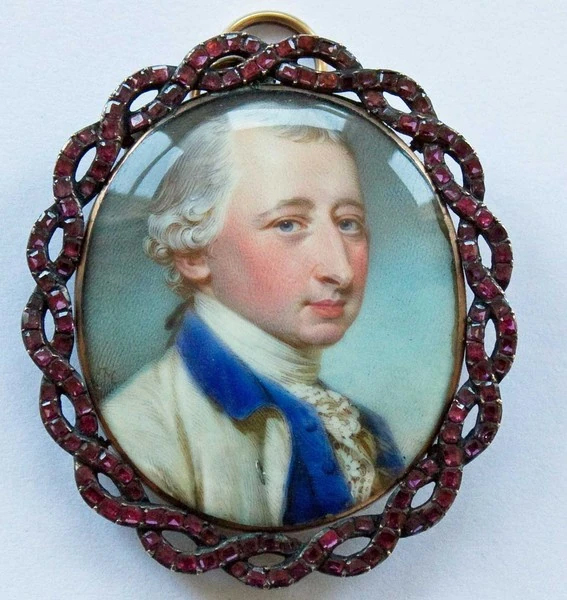Many of the officers who became generals in the Continental Army started out with noble intentions but politics and business often pulled them away from fighting against Great Britain to more personal goals. John Sullivan returned to Congress after his successful expedition against the Indians and Tories. Joseph Reed served as aide to George Washington but retired from the army after making brigadier general and being offered command of the cavalry. Another newly appointed brigadier general, John Philip de Haas, resigned from the army in the middle of the conflict for personal reasons. But his career did not end with his resignation.
Born in Holland, de Haas was raised in the area of Lancaster, Pennsylvania. He distinguished himself in the French and Indian War and also in Pontiac’s War in 1763. When the war against Great Britain began, he organized his own company and joined the main army. He advanced quickly through the ranks of the Continental service. He led troops that covered Benedict Arnold’s retreat from Canada. His Pennsylvanians performed meritorious service on the northern front and Congress appointed him a brigadier general in the Continental service on February 21, 1777.
After receiving his commission, the new brigadier general seemed to disappear, he was not with his regiment and he did not acknowledge receipt of the commission. George Washington eagerly awaited his arrival in New Jersey as a brigade command awaited him. Washington explained his early attempt to contact the missing general in a letter to Congressional president John Hancock on May 10, 1777:
I have not heard from Genl DeHaw’s since his promotion. As soon as I was informed of it, I wrote & requested him to repair to Camp, but having received no Answer I am apprehensive my Letter miscarried. I wish Congress to give him notice of his Appointment and directions to join the Army, if he accepts his Commission & is not prevented by indisposition.[1]
But there was no communication from the new general. In a letter to Washington on February 23, 1777 from Philadelphia, Horatio Gates revealed what he thought was the problem:
…Colonel De Haas left this City the day after I set out for Morris Town, & is not yet returnd, I understand his Son was extremely Ill, which occasioned his going to Lebanon. I am somewhat apprehensive he rather disinclines to serve another Campaign, … This Tardiness, & diffidence in Certain Individuals of This State, is most pernicious to the publick Service, there has been such Disputes about rank…[2]
Washington wrote letters to de Haas seeking clarification of his status but received no reply. Gates again wrote from Philadelphia to shed a little light on the mystery in a letter to Washington on March 7, 1777:
…It is more than Ten days ago since I wrote to General De Haas desiring His attendance in this City. Your Excellencys last Letter to him went Yesterday, If he is not detain’d at home by the Gout, nor does not Decline the Acceptance of his Brigadiers Commission, I take it he will come to Town directly.[3]
Did de Haas accept the proffered promotion? Would he join Washington? At the end of a long letter to John Hancock on June 13, 1777, the Virginian revealed his frustration:
I shall be glad to be informed, Whether Genl DeHaas, considers himself an Officer in the Army. He has never joined it since his promotion or written a single line to me upon the subject. If he accepts his Commission, it will be well for Congress to order him to repair to the Army immediately. The Brigade intended for him, is without a Genl Officer, and has brought on a disagreeable dispute between two of the Cols. each claiming the command. This is not the only inconvenience. Officers of high rank, remaining at Home, afford a bad example to Others, who are inferior, and grounds for the like indulgence.[4]
Congress took Washington’s advice and passed a resolution on June 16, 1777 ordering de Haas to report to Washington’s headquarters.[5] The end of de Haas’ career seemed to come when Washington received a letter from Richard Peters, secretary of the Congressional Board of War,[6] dated 19 June 1777 that ended:
P.S. I am directed to inform your Excellency of General De Haas Resignation.[7]
That was it. The career of General John Philip De Haas ended under shadowy circumstances. Whether it was due to illness or personal interests, no one knew, and de Haas settled into the life of a successful businessman in the Philadelphia area.
But history had not seen the last of de Haas. On July 3, 1778, Indians and Tories raided in the Wyoming Valley, a rich farm area a little over 100 miles north of Philadelphia near present day Wilkes-Barre. It was just one of many attacks along the frontier. Hundreds of homes were destroyed and many settlers were killed before the Indians and their allies retreated. De Haas owned over 800 acres along the frontier west of the Wyoming (a few miles west of present day Williamsport) and had business interests in Lebanon and Easton, two towns about 80 miles northeast of Philadelphia. Easton was less than forty miles from the Wyoming Valley. His land was rich farmland and some of his family lived in Lebanon. The nearness of the attacks to his personal interests spurred de Haas into action. He sent a letter to the Board of War:
The Honorable Richard Peters, Esq.
Member of the Board of War
Philadelphia
Lebanon, Pa., July 13th, 1778
Sirs:-
Upon frequently learning that the Indians were committing murders and other outrages at Wyoming I desired Colonel Grubb to send an Express to Colonel Hunter to know the certainty, he is returned from Garber’s Mill above Harper’s Ferry and brings the following intelligence.
I would immediately oppose them with a number of men which I think highly expedient, but as such measures ought not to be prosecuted without instructions. I would be much obliged to you to let me know the sentiments of the Hon’ble the Board of War upon the occasion.
If it is agreeable, send me power to draw ammunition for the purpose.
I am sir, your
Most obed’t and humble Serv’t
J.P. DE Haas[8]
After receiving the note from de Haas, the Board of War agreed to de Haas’ offer and forwarded his letter, along with instructions, to the Vice President of the Executive Council of the State of Pennsylvania on July 16, 1777:[9]
Hon’ble George Bryan, Esq.
Vice President, as follows:
The enclosed letter from Genl. De Haas, we send for your perusal. We propose desiring him to march with all the men he can collect, and to give him orders to draw ammunition and other necessaries for the purpose. This voluntary offer of Gen. de Haas gives us great pleasure, we doubt not it will prove beneficial to the numbers that join him; and trust it will meet the approbation of the Council, we wish indeed he had not waited for orders, but marched immediately with all the force he could draw together, for the incursions of Indians are so sudden and rapid, that a county must be exposed to utter devastation, unless the Militia rush out at once where danger threatens, without waiting formal orders of Supreme Power, which must unavoidably attended with great delays.
We are sir, your most obed’t Servants,
By order of the Board,
Tim Pickering
All references to de Haas at this point were as a general, evidently he had accepted his commission as brigadier general. The same day that Bryan received the letter, July 16, 1777, Vice President Bryan quickly notified the local commander in Lancaster, Colonel Bertram Galbraith:
Colonel Pickering in the name of the Board of War has this day communicated to Council a letter from Gen. de Haas offering his services in leading a body of volunteers against the Indians.
Council applaud the spirit of the Gentleman on this occasion, and wish you to give him your utmost countenance. They rejoice to find an officer of weight and experience, stepping forth in defense of his country. I am sir,
Your most Obed’t Serv’t,
George Bryan, Vice. Prest.[10]
De Haas quickly moved to the frontier with a small party of men and began organizing defenses and arranging for the promised supplies. Soon after de Haas arrived on the frontier, Colonel Thomas Hartley was ordered by the commander of local Continental forces, Benedict Arnold, to move to the frontier and prepare defenses before the return of the Indians and Tories. When Hartley arrived with regular Continental troops, de Haas graciously gave up command to Hartley and, after helping to prepare the defense of the upcoming harvest, returned to Easton, and eventually to Philadelphia. Hartley was so impressed with the unselfish spirit of de Haas that he penned a note to the board of war, praising as well alluding to a hoped for return of the general:
General de Haas came up here with the intention of assisting and supporting the people, he was successful in these particulars, he gave directions concerning the Militia, and those that arrived were well disposed of (in my opinion), according to my instructions I have taken command. The General’s zeal on this occasion has been of advantage: he will, I believe as soon as he is better of the Gout, return to Lebanon. The stores he furthered on from there were much wanted.[11]
The threat to his holdings removed, de Haas returned home. He moved to Philadelphia in 1779. On September 30, 1780, de Haas was brevetted Major General.[12] There is no further record of military service. Perhaps it was the ‘gout’ that prevented him from continuing in service but whatever the reason, General de Haas spent the remaining years of his life in various businesses, including iron and wheat marketing. He died a wealthy man in 1786 and is buried in the graveyard of the German Reformed Church in Easton.
[1] Philander D. Chase, ed., The Papers of George Washington, Revolutionary War Series, Volume 9, March-June 1777 (Charlottesville: University Press of Virginia), 373.
[2] Frank E. Grizzard, ed., The Papers of George Washington, Revolutionary War Series, Volume 8, January-March 1777 (Charlottesville: University of Virginia Press, 1998), 423.
[3] Ibid., 533.
[4] Frank E. Grizzard, ed., The Papers of George Washington, Revolutionary War Series, Volume 10, June-August 1777 (Charlottesville: University of Virginia Press, Charlottesville, 2000), 28.
[5] “Journals of the Continental Congress,” American Memory, Library of Congress, http://memory.loc.gov/cgi-bin/query/r?ammem/hlaw:@field(DOCID+@lit(jc00823, accessed February 21, 2015.
[6] The Board of War was created by Congress as “…essentially a deliberative body which submitted proposals to Congress for action.” See Philander P. Chase, The Papers of George Washington, Revolutionary War Series, Volume 5, June-August 1776 (Charlottesville, University Press of Virginia), 63.
[7] Grizzard, The Papers of George Washington, 10:76.
[8] Abram Hess, The Life and Services of General John Philip de Haas, 1735-1786, Paper Read before the Lebanon County Historical Society, February 10, 1916 (Lebanon, Pa.: Lebanon Historical Society), 85.
[9] The Council provided the executive functions in lieu of a governor for Pennsylvania.
[10]Ibid, 86.
[11]Ibid, 87.
[12] Francis B. Heitman, Historical Register of Officers of the Continental Army during the War of the Revolution (Baltimore: Genealogical Publishing Co, Inc., 1982) 192.








One thought on “Brigadier General John de Haas: A Bad Example to Others”
Very interesting. I am looking for information on John Phillip De Haas’s men, particularly Captain John Nelson and brother Thomas Nelson of the Independent Company of riflemen of Westmoreland county Pa. Have you ever run across anything on them during your own research of the Revolutionary War?
Thank you!
Charlene M